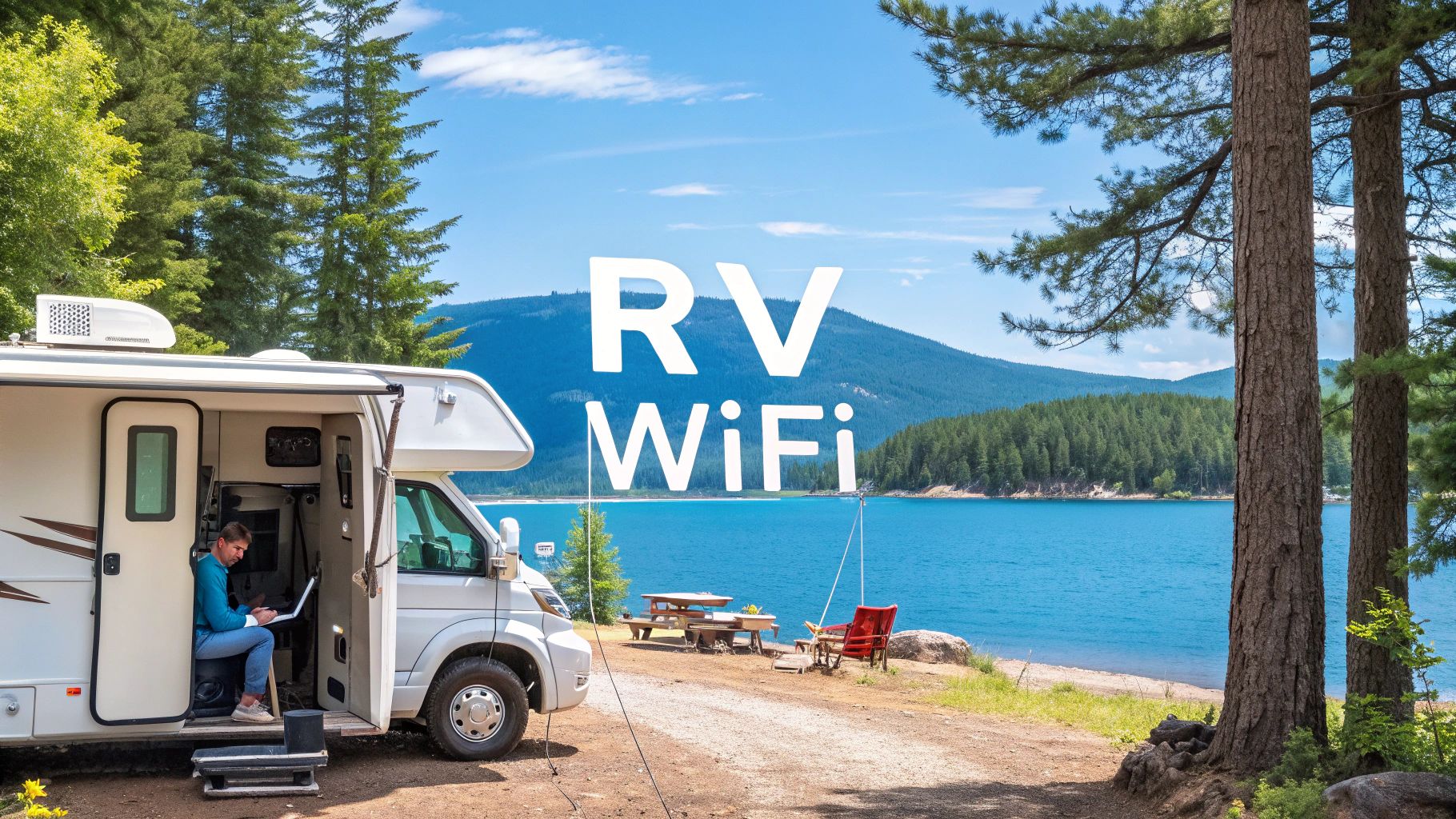

· By James
How to Get WiFi for RV: Complete Guide to Stay Connected
Figuring out how to get decent WiFi in an RV can feel like a tangled mess of cords and antennas. But really, it all comes down to a few core choices. For most of us hitting the road today, a good cellular hotspot is the sweet spot, balancing performance, cost, and the freedom to roam.
Your Guide to Reliable RV WiFi
Let’s be honest: having a solid internet connection in an RV has gone from a nice-to-have luxury to a basic utility, just like your water and power hookups. Whether you're a full-time digital nomad, a weekend warrior, or taking the family on a cross-country trip, the days of shrugging off a non-existent signal are long gone.
This need for constant connectivity is changing the entire RV landscape. It's no surprise that the market for RV parks and campgrounds is expected to jump from USD 6.99 billion in 2024 to over USD 11.17 billion by 2034. That growth, highlighted in recent market research from Precedence Research, is being driven by people like us—travelers who need the internet to work, play, and navigate.
This guide will cut through the technical jargon and help you piece together a setup that actually works for your travel style.
RV WiFi Options at a Glance
Before you start buying gear, it's helpful to see how the main options stack up against each other. Each has its place, and knowing the pros and cons will save you a lot of headaches down the road.
| WiFi Method | Best For | Pros | Cons |
|---|---|---|---|
| Cellular Hotspot | Most RVers, especially digital nomads and frequent travelers. | Flexible, great coverage, works while in motion. | Dependent on cell signal, data caps can be an issue. |
| Campground WiFi | Casual users, budget travelers, or as a backup. | Often free or cheap, easy to connect to. | Notoriously slow, unreliable, and not secure. |
| Satellite Internet | Boondockers, off-grid adventurers, and those needing high speeds anywhere. | Works in remote areas without cell service, very fast. | High upfront cost, requires a clear view of the sky, can't be used while moving. |
As you can see, there's no single "best" solution for everyone. The right choice depends entirely on where you go and what you do online.
Understanding Your Primary Options
Now, let's dig a little deeper into what each of these really means for you on the road.
-
Cellular Hotspots: Think of these as your own personal WiFi bubble. They tap into the same mobile networks as your smartphone (like Verizon, AT&T, or T-Mobile) to create a private, password-protected network for your devices. They’re the go-to for a reason: they offer incredible flexibility and work just about anywhere you can get a cell signal. Perfect for people who are always on the move.
-
Campground WiFi: This is the most basic option out there. You pull into your site, get the password from the office, and connect. While it's often free, the performance is famously unpredictable. Picture the entire campground trying to stream movies on a rainy Saturday night—it slows to an absolute crawl. It’s okay in a pinch, but you can’t count on it for anything important.
-
Satellite Internet: For those who truly want to get away from it all, systems like Starlink are a game-changer. They pull a high-speed signal straight from the sky, meaning you can be in the middle of a desert and still host a video call. The downside? A hefty initial investment for the hardware and the need for a wide-open, unobstructed view of the sky.
The real secret to staying connected without tearing your hair out is to not put all your eggs in one basket. Relying on a single source of internet is a recipe for frustration. Most seasoned RVers I know run a hybrid system—a primary cellular plan for everyday use, with campground WiFi serving as a weak but sometimes-useful backup.
Choosing Your Primary Internet Source
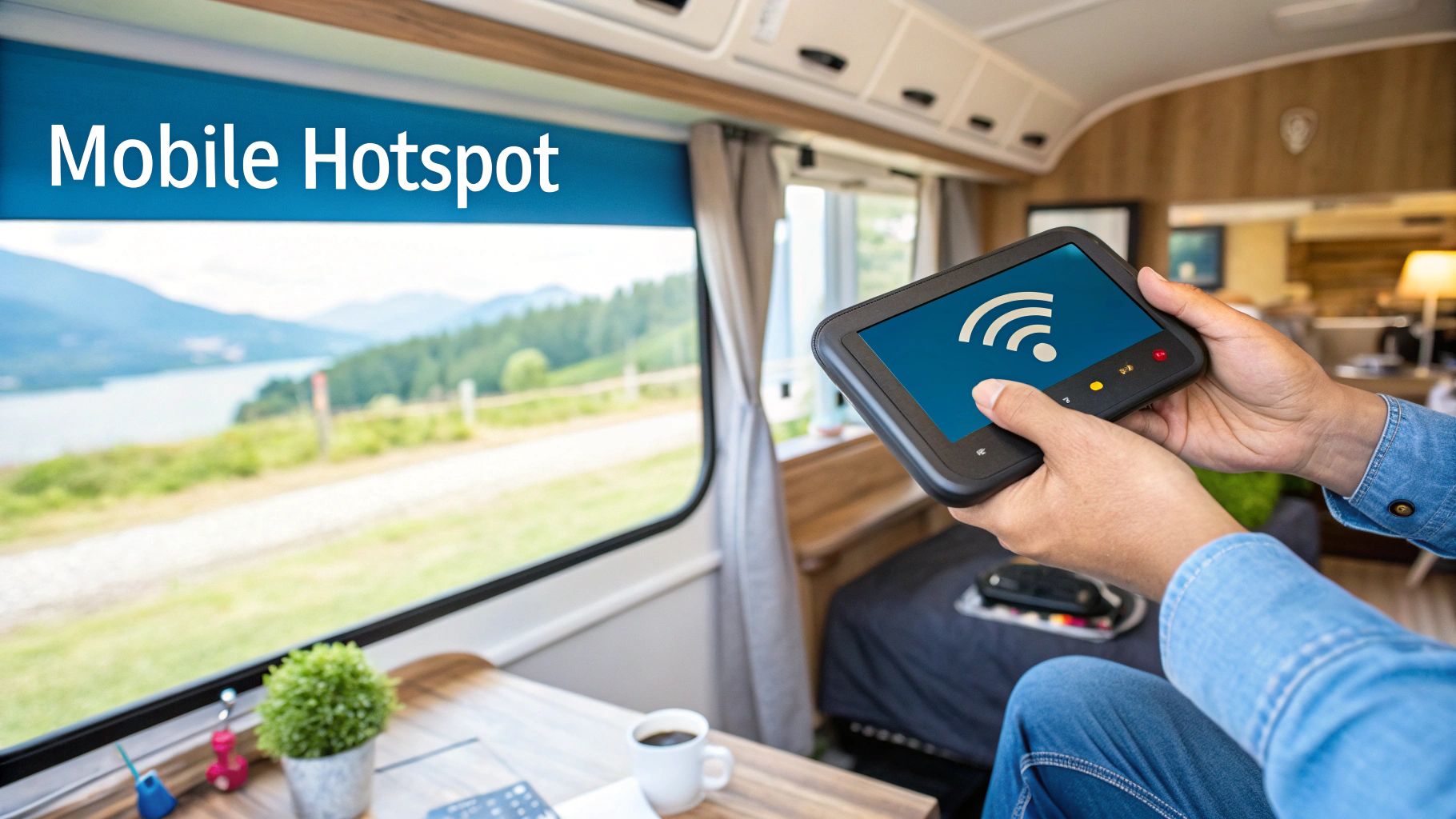
Your primary internet source is the absolute foundation of your mobile life. Getting this right isn't about finding one "best" option for everyone. Instead, it's about being honest about your travel style and daily needs, then matching the right tech to that reality.
When it comes to RV internet, you're looking at three main pillars: cellular data, satellite systems, and public WiFi. Let's get into the practical side of each one. We'll figure out which should be your go-to, which makes a solid backup, and which one you can probably skip.
Cellular Data: The RVer’s Workhorse
For the huge majority of us out on the road, cellular data is the most practical and reliable way to stay connected. It’s simple: a mobile hotspot device creates your own private WiFi network right inside your rig, pulling its signal from cell towers just like your phone does.
I can't stress this enough: a dedicated mobile hotspot (sometimes called a MiFi) is almost always a smarter move than just using your phone's hotspot. These little devices are built for one thing—delivering a stable connection to your laptops, tablets, and TVs. They have much better antennas, and they won't kill your phone's battery or drop your connection every time a call comes in.
The biggest headache with cellular is navigating the data plans. You'll see "unlimited" advertised everywhere, but the fine print often mentions deprioritization. This is when the carrier intentionally slows your speeds after you hit a certain data cap. Trust me, it always seems to happen right in the middle of an important video meeting.
Pro Tip: Before you even think about booking a campsite, check the carrier's coverage map. But don't just trust their website's version—use real-world sources like Campendium. You'll find reports from other RVers on actual signal strength in that exact spot. A few minutes of research can save you a week of digital misery.
Satellite Internet: For Ultimate Freedom
Satellite internet, especially with Starlink leading the way, has been a total game-changer for off-grid travel. It works by talking directly to satellites, which means you can get blazing-fast internet in places where cell service is just a distant memory.
But before you jump in, know that satellite comes with its own set of real-world challenges. The initial hardware cost is pretty steep, and the system needs a wide-open, clear view of the sky. This gets tricky in beautiful, heavily wooded campgrounds or down in narrow canyons. A handful of trees is often all it takes to kill your signal.
Power is the other big consideration, particularly if you love to boondock. That satellite dish—or "Dishy" as it's known—can be a real power hog. You’ll need a solid power system, like a good solar setup or a generator you don't mind running, to keep it online without constant battery anxiety. It's an incredible piece of gear, but it definitely requires you to plan ahead.
For a deeper dive into all the different ways to get online, you should check out our guide on easy and reliable RV internet solutions.
Public and Campground WiFi: The Last Resort
Finally, we have public WiFi, which you'll most often find at campgrounds. The idea of a free or cheap connection is always appealing, but the reality is usually a letdown. These networks are shared by everyone in the park, and once the evening rush hits, performance often slows to a crawl.
It’s best to think of campground WiFi as a potential bonus, not a reliable tool. It might be good enough for some light web browsing or checking email late at night when the network traffic dies down. But you should never, ever count on it for remote work, streaming a movie, or anything else that needs a stable, secure connection.
Here’s when it might actually come in handy:
- As a backup: If your main cellular or satellite setup goes down for some reason, it’s better than having no connection at all.
- For non-essential tasks: You could use it to download a huge file overnight, saving precious data on your primary plan.
- In well-equipped parks: Some high-end RV resorts do invest in powerful WiFi systems that can be surprisingly good. Just know this is the exception, not the rule.
Boosting Your Signal for Better Connectivity
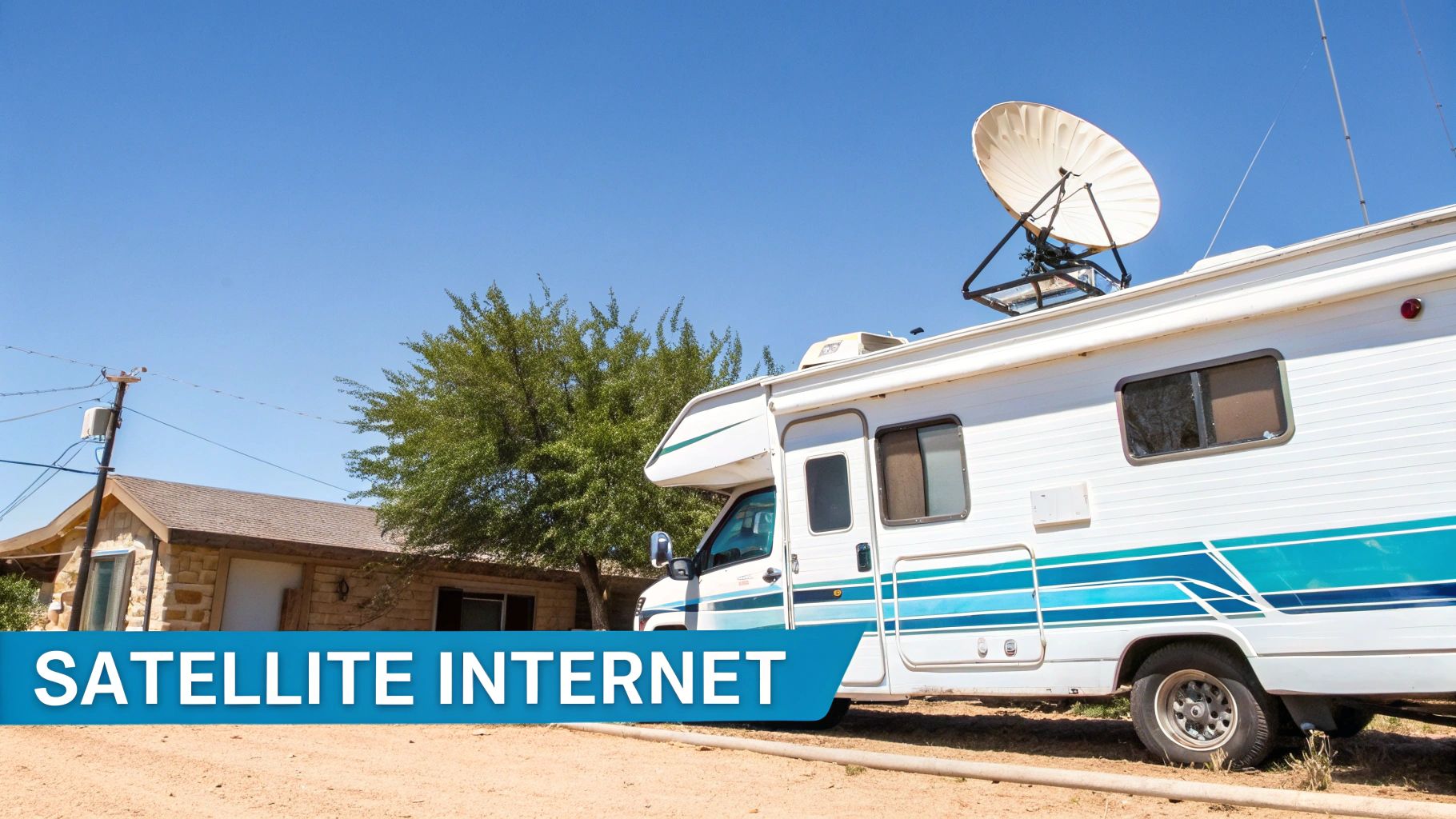
So you've got a great internet source. That’s a fantastic start, but it's only half the equation. The signal from a distant cell tower or campground router still has to fight its way to your devices, and your RV's metal and fiberglass shell is surprisingly good at stopping it dead in its tracks.
This is where signal boosters come in, but it’s absolutely crucial to know which kind you need.
I’ve seen countless RVers buy the wrong piece of gear, get frustrated, and assume nothing works. Let's clear up the confusion between the two main players: cellular boosters and WiFi extenders. They sound similar, but they solve completely different problems. Using the right one at the right time is the key to finally getting that reliable connection you're after.
Understanding Cellular Boosters
A cellular booster is designed to solve one very specific problem: a weak cell signal. Think of it as a megaphone for your cellular connection. It grabs a faint, barely-usable signal from outside your RV, amplifies it, and then blasts that stronger signal inside your rig.
This tech is a lifesaver for anyone who relies on a mobile hotspot or their phone for internet. It’s especially valuable for boondockers or anyone camping in remote state parks where cell towers are few and far between.
A typical cellular booster system has three main parts:
- An External Antenna: This mounts on your RV’s roof or ladder to capture the best possible signal from the outside world.
- An Amplifier: This is the brain of the operation, taking that weak signal and juicing it up.
- An Internal Antenna: This small antenna broadcasts the newly strengthened signal inside your RV for your hotspot and phones to use.
A common mistake is thinking a booster can create a signal out of thin air. It can't. It can only amplify an existing signal, even if it's extremely weak. If you're in a complete dead zone with zero service, a booster won't be able to help.
Leveraging WiFi Extenders
A WiFi extender (sometimes called a WiFi repeater) serves a totally different purpose. Instead of working with cellular signals, it focuses on existing WiFi networks, like the one offered at a campground. Its job is to grab that distant, often weak WiFi signal from the park's office or router and rebroadcast it as a new, private, and secure network inside your RV.
This is a great tool when the campground WiFi is decent but just doesn't quite reach your specific campsite. It also creates a personal network, which is much more secure than connecting all your devices directly to a public, shared network that everyone else is on.
Heads up, though: a WiFi extender can’t fix a fundamentally bad internet connection. If the campground’s WiFi is overloaded and slow, the extender will just give you a stronger signal of that same slow internet. For a more detailed look at different models, check out our guide on finding the best RV WiFi booster for your travel style.
Making the Right Choice
So, which one do you need? It all comes down to your primary source of internet.
- If you use a cellular hotspot for internet: You absolutely need a cellular booster.
- If you rely on campground WiFi: You might benefit from a WiFi extender.
Many full-time or serious RVers eventually invest in a system that combines both capabilities. A popular and growing option involves dedicated portable cellular devices from services like EZ Mobile Data, which offers unlimited 5G connectivity designed for RV use. As of 2025, the company claims 99% coverage across the U.S. by using major cellular networks for unthrottled, high-speed internet perfect for remote work. While this requires an upfront router investment, it provides significant flexibility. You can learn more about how this type of portable WiFi for RVs is changing the game for travelers.
Selecting the Right Data Plan for Your Needs
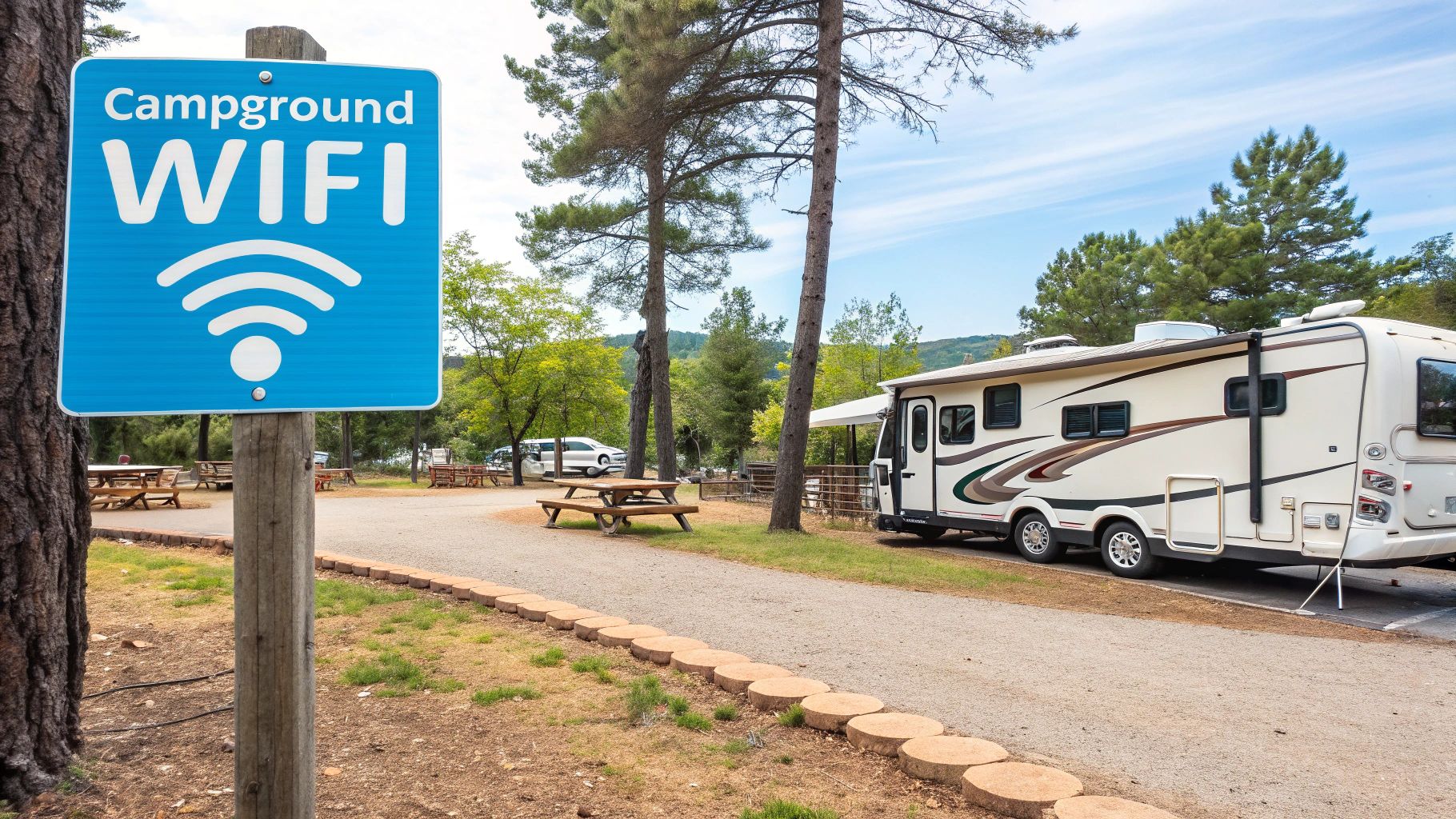
Choosing your hardware is a solid first step, but let's be real—the data plan you pair it with is what truly defines your online freedom. A powerful hotspot with a stingy, slow data plan is like putting a lawnmower engine in a sports car. This is where you actually connect your gear to the internet, and picking the right plan is the difference between a smooth ride and a frustrating one.
The world of data plans can feel intentionally confusing, filled with jargon that sounds way better than it is. To make sure you get real value and performance for your RV life, it helps to understand the ins and outs of finding the best broadband deals. This knowledge helps you see past the flashy marketing and focus on what you actually need on the move.
Decoding “Unlimited” Plans
The word "unlimited" is probably the biggest trap in the cellular world. While you can technically use as much data as you want, carriers almost always slip in a deprioritization threshold. Once you hit a certain amount of data in a month—say, 50GB—your connection gets shoved to the back of the line.
When you're in a busy area or it's peak usage time, this means your speeds can plummet. Forget video calls, and get ready for a pixelated mess when you try to stream anything. Some plans go even further with hard throttling, slowing your speeds to a crawl after your limit, no matter how busy the network is.
Here’s what that looks like in the real world: You're working from a popular RV park and hit your 50GB limit mid-month. All of a sudden, your solid connection becomes completely useless for that afternoon Zoom meeting. This is exactly why knowing your plan's actual high-speed data limit is so much more important than just seeing the word "unlimited."
How Much Data Do You Actually Need?
Before you start shopping for plans, you need a realistic idea of your monthly data usage. Overbuying is a waste of money, but I can tell you from experience that underbuying is way more disruptive.
Here's a simple framework to get a rough estimate:
- Light Use (Email, Web Browsing): 10-30GB per month
- Moderate Use (Social Media, Music, some SD Streaming): 30-75GB per month
- Heavy Use (Remote Work, HD/4K Streaming, Gaming): 100GB+ per month
For instance, a couple working full-time from their rig, streaming a movie every night, and hopping on regular video calls could easily chew through 200-300GB of data a month. If that sounds like you, our breakdown of the top 8 best internet options for RV living is a great place to start your research.
Comparing Carriers and Resellers
Your main choices for data plans come down to the big carriers—Verizon, AT&T, and T-Mobile—or third-party resellers. Each has its pros and cons.
- Major Carriers: You get direct customer service and a bunch of plan options. The downside? Their best hotspot plans can be pricey or come with lower data caps that you'll burn through quickly.
- Third-Party Resellers: These companies often buy data in bulk from the major carriers. The result is that they can sometimes offer plans with much higher—or even truly unlimited—data allowances designed specifically for RVers.
A final word of advice: always check the coverage maps for all three major carriers in the areas you plan to travel. No single provider is the best everywhere. Having a plan that uses the strongest network for your intended destinations is absolutely key to making sure your gear can deliver the reliable connection you paid for, wherever you decide to roam.
Putting It All Together: Your Integrated RV WiFi System
You've picked out your hardware and sorted out a data plan. Now it's time for the fun part: making it all work together. The goal here isn't just to plug a few things in; it's to build a cohesive, reliable network that hums along in the background. You want a system you can practically set and forget, freeing you up to focus on the adventure, not your signal bars.
A classic, battle-tested setup involves a few key components playing nicely together. It usually starts with an external antenna on your RV's roof, pulling in the strongest possible cellular signal from the outside. That signal then gets fed into a booster, which gives it a serious kick before passing it along to your mobile hotspot or dedicated router. From there, the router creates a private, powerful WiFi network that covers your entire rig.
This diagram gives you a quick visual of how a system like this comes to life.
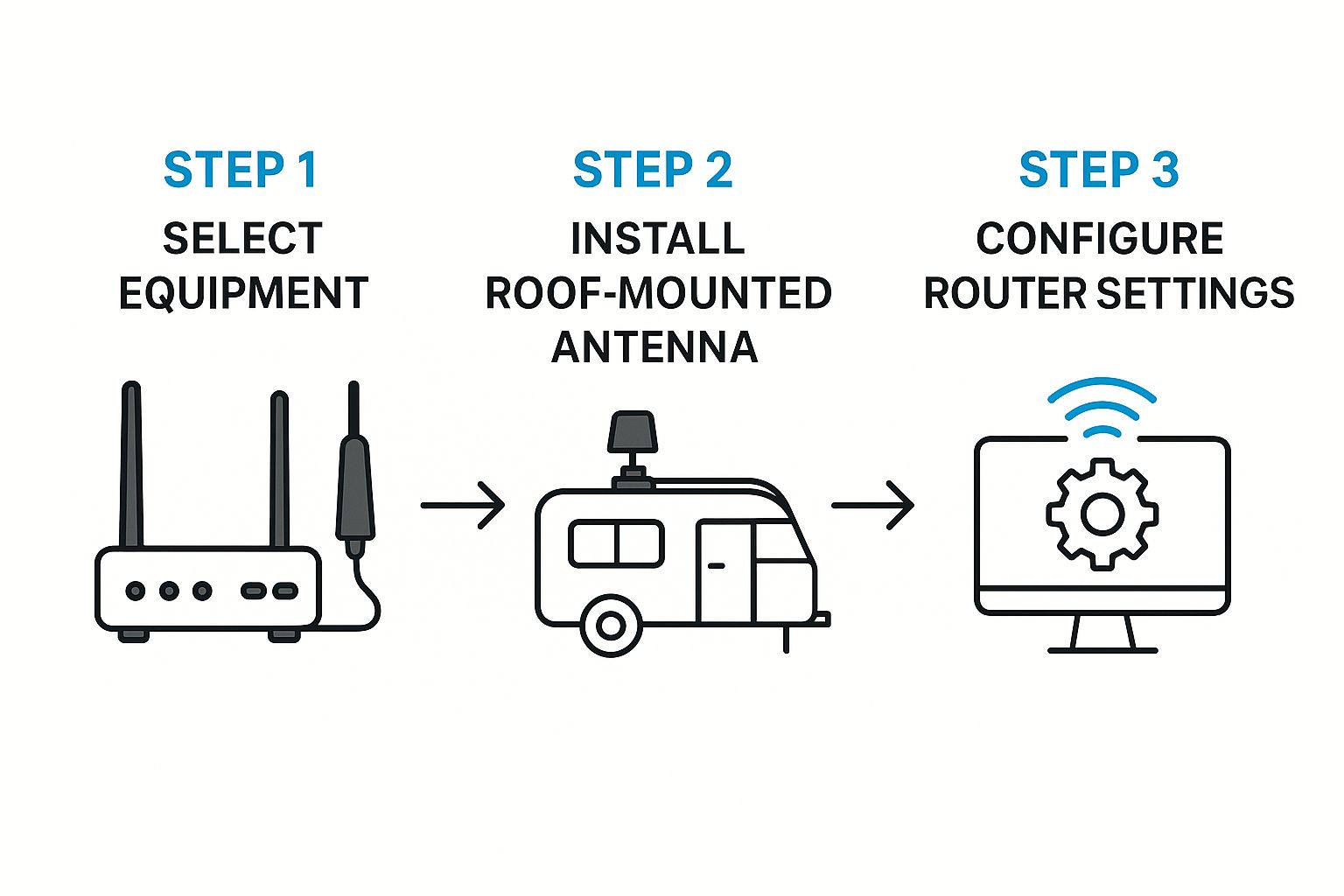
As you can see, a great setup flows from choosing the right gear to a smart installation, and finally, to tweaking your router's settings to get the best performance.
A Real-World Example
Let's look at a common scenario. Imagine a couple, Sarah and Tom, who work from the road and need a bulletproof connection for video calls and big file transfers. Here’s a peek at how they might build their system:
- External Antenna: They’ve mounted a directional antenna on a collapsible pole right on their RV ladder. This allows them to aim it precisely at the nearest cell tower, grabbing the cleanest signal possible.
- Cellular Booster: The antenna cable snakes inside to a cell booster, neatly tucked away in a cabinet. This little box is the muscle, amplifying that weak signal into something strong and stable.
- Mobile Router: Finally, the booster is connected to a dedicated 5G mobile router. This device, powered by their high-data plan, acts as the brain of their network, managing all their connected gadgets.
This kind of integrated system means they get a solid, fast connection even in those fringe service areas where a simple phone hotspot would be totally useless.
The real magic of an integrated system is that you only have one WiFi network to manage. Once configured, every device—laptops, phones, smart TV, and tablets—connects to your single RV network. You don’t have to constantly switch between campground WiFi and your hotspot.
This push for reliable connectivity is changing the whole RV landscape. Dependable WiFi has become a must-have for RV parks, thanks to the explosion of remote workers and families who need it for work, school, and entertainment. Many parks are even adding amenities like coworking spaces to draw in digital nomads, proving that good internet is now a top-tier service. For more on this, you can check out some fascinating U.S. RV park industry trends on Analytics.Loan.
To help you visualize how these pieces fit together, here's an example of a complete system build. This table breaks down what each component does and how it connects to the others, giving you a blueprint for your own setup.
Sample RV WiFi System Build
| Component | Example Product | Function | Integration Note |
|---|---|---|---|
| External Antenna | Poynting MIMO-3-17 | Captures cellular, WiFi, & GPS signals from outside the RV. | Mount on the roof for a 360-degree view, clear of obstructions like AC units. |
| Cellular Booster | weBoost Drive Reach RV | Amplifies weak cellular signals to improve voice and data reliability. | Place the indoor antenna away from the external one to prevent oscillation. |
| Mobile Router | Pepwave MAX BR1 Pro 5G | Creates a private WiFi network and manages data from multiple sources (cellular, Starlink, campground WiFi). | Connects to the booster's indoor antenna and accepts SIM cards directly. |
| Data Plan | TravlFi Journey1 | Provides the cellular data needed to power the router's connection. | The router will use this plan as its primary internet source when on the move. |
This combination creates a robust, multi-faceted system that can handle just about any connectivity challenge you throw at it, from remote boondocking sites to crowded campgrounds.
Key Installation Tips
A clean installation is just as important as the gear itself. Keep your cable management tidy—use wall clips and zip ties to secure wires and prevent them from getting snagged or damaged when you're on the move.
Make sure your router and booster have a stable power source. Tapping directly into your 12V system is usually more efficient than using an inverter, which is a big plus if you love boondocking.
And one last thing: always secure your network with a strong, unique password. It's a simple step that keeps your connection private and your neighbors out.
Answering Your Top RV WiFi Questions
Even with the best gear, questions always come up. I get it—the tech can feel a little overwhelming when you're just trying to get online. But the answers are usually pretty simple once you break them down.
Let's walk through some of the most common questions we hear from fellow travelers. My goal is to help you feel confident in your setup and know what to do when things get glitchy.
One of the biggest hang-ups I see is the confusion between a mobile hotspot and a dedicated mobile router. Your phone's hotspot or a little MiFi device is great for quick, casual use. They're simple and portable. But a mobile router? That's a whole different beast—a more powerful, permanent solution designed specifically for life on the road. It packs better antennas, more processing power, and can even juggle multiple internet sources at once.
Think of it this way: a hotspot is a temporary fix, while a router is the command center for your entire mobile network.
Do I Really Need an External Antenna?
This question comes up all the time, and my answer is almost always a resounding yes. A roof-mounted external antenna is probably the single most important upgrade you can make to your connectivity setup. Your RV's walls, especially if they have any metal in them, are signal killers.
An external antenna grabs the signal before it has to fight its way inside your rig.
In those fringe service areas, an external antenna can mean the difference between a slow but usable connection and no connection at all. It pulls in a much cleaner, stronger signal for your booster and router to work with, which can dramatically improve both your speed and reliability.
How Do I Manage WiFi for the Whole Family?
Keeping a whole family of devices connected on the road sounds like a headache, but a good mobile router actually makes it pretty easy. Instead of everyone fumbling with a weak campground signal or draining their phone batteries on individual hotspots, you create one central, secure network for the entire RV.
This kind of setup has some serious perks:
- Centralized Control: You're only managing one network and one data plan. It makes it so much easier to keep an eye on how much data everyone is using.
- A Stronger Signal for Everyone: Your router, powered by that external antenna and maybe a booster, blankets the whole rig in a powerful signal.
- Better Security: All your family's devices are tucked safely behind your router's firewall. That's a world away from connecting directly to sketchy public campground WiFi.
By funneling everything through a single, robust system, you make sure everyone gets a stable connection—from the kids streaming cartoons to you hopping on a video call for work. It just simplifies everything and puts an end to the family bandwidth battles before they even start.
For a no-hassle, high-speed connection that keeps up with your travels, SwiftNet Wifi offers powerful 5G internet solutions designed for RVers and rural homes. Explore our plans today and stay connected wherever the road takes you.

